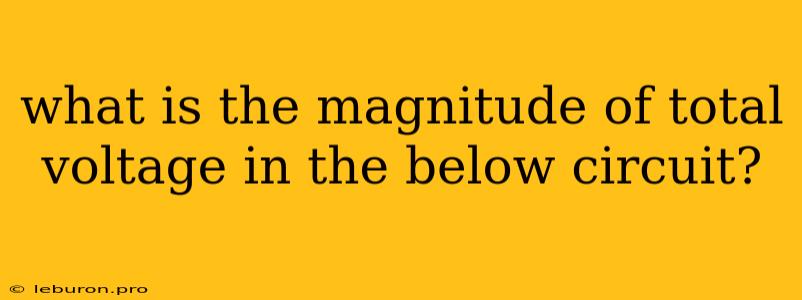Determining the magnitude of the total voltage in a circuit is a fundamental concept in electrical engineering. It involves understanding the relationships between voltage, current, and resistance, as well as the different types of circuits and their behavior. This article will delve into the process of calculating total voltage in a circuit, exploring various scenarios and providing practical examples.
Understanding Voltage and Circuits
Voltage, often referred to as electrical potential difference, is the driving force that pushes electric current through a circuit. It is measured in volts (V). A circuit is a closed loop consisting of components such as resistors, capacitors, inductors, and power sources connected by wires.
Types of Circuits:
- Series Circuits: Components are connected one after another, forming a single path for current to flow. The total resistance in a series circuit is the sum of individual resistances.
- Parallel Circuits: Components are connected side-by-side, providing multiple paths for current to flow. The total resistance in a parallel circuit is calculated using the reciprocal of the sum of reciprocals of individual resistances.
Calculating Total Voltage
The method for calculating total voltage depends on the type of circuit and the components present. Here are the key principles:
Kirchhoff's Voltage Law (KVL):
This fundamental law states that the sum of all voltages around a closed loop in a circuit is equal to zero. This principle is crucial for analyzing circuits and determining the voltage across specific components.
Ohm's Law:
Ohm's Law describes the relationship between voltage (V), current (I), and resistance (R): V = I * R. This law is essential for calculating voltage, current, or resistance in circuits.
Examples of Calculating Total Voltage
Here are some practical examples of calculating total voltage in different circuit scenarios:
Example 1: Series Circuit
Consider a series circuit with two resistors, R1 = 10 ohms and R2 = 20 ohms, connected to a 12V battery.
- Total Resistance (Rtotal): Rtotal = R1 + R2 = 10 ohms + 20 ohms = 30 ohms
- Total Voltage (Vtotal): Vtotal = I * Rtotal. To find the current (I), we can use Ohm's Law: I = Vtotal / Rtotal = 12V / 30 ohms = 0.4A. Therefore, Vtotal = 0.4A * 30 ohms = 12V.
Example 2: Parallel Circuit
Imagine a parallel circuit with two resistors, R1 = 5 ohms and R2 = 10 ohms, connected to a 9V battery.
- Total Resistance (Rtotal): 1/Rtotal = 1/R1 + 1/R2 = 1/5 ohms + 1/10 ohms = 3/10. Therefore, Rtotal = 10/3 ohms.
- Total Voltage (Vtotal): Vtotal = I * Rtotal. Since the voltage across each branch in a parallel circuit is the same, Vtotal = 9V.
Factors Affecting Total Voltage
Several factors can affect the total voltage in a circuit, including:
- Voltage Source: The voltage of the power source directly influences the total voltage in the circuit.
- Resistance: The resistance of components within the circuit affects the current flow and, consequently, the voltage across each component.
- Load: The amount of current drawn by the load (devices connected to the circuit) can affect the voltage drop across the circuit.
Applications of Total Voltage Calculation
Understanding the magnitude of total voltage is essential in various electrical and electronic applications, including:
- Power Supply Design: Determining the required voltage for electronic devices and systems.
- Circuit Analysis: Troubleshooting and optimizing circuit performance by analyzing voltage distribution.
- Power Transmission: Ensuring efficient and safe transmission of electrical power over long distances.
Conclusion
Calculating the total voltage in a circuit is crucial for understanding and analyzing electrical systems. By applying the principles of Kirchhoff's Voltage Law, Ohm's Law, and understanding the characteristics of different circuit configurations, one can accurately determine the total voltage in a circuit. This knowledge is essential for various applications, including power supply design, circuit analysis, and power transmission.
